| Title Native American Family History Research Using GIS | |
|
Author Jennifer Buchanan American River College, Geography 350: Data Acquisition in GIS; Spring 2010 mytg06@yahoo.com 
| |
|
Abstract A GIS (Geographic Information System) is beginning to be a useful application for genealogy. In particular, the ESRI (Environmental Systems Research Institute, Inc.) software products provide tools that can enhance the researching tasks involved with analyzing a family tree and the geographical properties of known ancestors. I am using Geographic Information Systems (GIS) to investigate my supposed Native American heritage, in order to attempt to separate fact from fiction and bring together stories, photos, maps and other evidence about potential Indian members of my family's past. My information collection and analysis takes me through Cherokee and various genealogy records, but I come to conclusions involving the Shawnee Indian tribe. | |
|
Introduction I am a true Heinz 57 when it comes to my ancestry, but when I was young, I remember recognizing my mother’s side of the family’s striking Native American features: the olive-dark complexion, auburn tented or black hair, and blue or copper-green eyes; and hearing the very vague family tale that we have Indian roots on both sides of my mother’s parents. My grandparents did not talk about the past or their relatives; in fact, my mother never met her grandparents or had even seen a photograph of them. When I got older, I went to a family reunion with my father’s side of the family. A distant cousin shared her scrapbooks with our family tree and pictures in it and the genealogy bug bit me. As far as my mother ever knew, her only living relatives did not have photographs or a clear memory of the, again, vague facts told to them, so the internet has been a great source of knowledge so far for researching her family. However, until recently, I haven’t had the opportunity to really visualize or digest any of the names, dates, places, text, photos, and other documents I have been accumulating over the years, or been able to resolve some of the stumbling blocks I’ve encountered, such as not even knowing which tribes we may belong to. As told in several Native American creation myths, the use of voice, such as singing, acts as a remembrance ceremony necessary for life to continue, because as tradition holds, the use of words in many forms is what created this life in the beginning. However, due to many factors, many descendants of Native Americans have been too far removed from that culture, our voices have disappeared in time, and the stories have not been retold to new generations. Even the most mundane information has been forgotten or is buried in someone’s attic or family archive. In keeping with ancient tradition, I take it to be my mission and destiny to try to discover, preserve, and retell our family history; and I believe ArcGIS provides the capabilities needed for unraveling and analyzing the massive amounts of information available in this technological age, so that our blood memory and the stories of our ancestors may still live on. No matter how long ago, heredity can be very powerful and influential, and knowing where we came from can help a person come to terms with the age-old question, “Who am I?” The subject is gaining popularity, with celebrities and TV shows investigating family genes, such as the new series “Who Do You Think You Are?” which just debuted this year on NBC . My plan is to use ESRI's ArcMAP product to restructure my hierarchal database structure, or basic family tree parent/child relationship, into a relational database structure. My goal is to maintain the tree-like structure above my map, in order to visualize the entire tree using simple zoom and pan functionality and view the pedigree in one seamless parent/child type structure, rather than broken up into a limited number of branches per page, as I did until this project. Family atlas style life maps can be generated in GIS, to aid research analysis capabilities, so that I may examine my possible Native American roots in greater detail. Websites, such as Ancestry.com , will be used to determine if I can find any valid documented proof or additional information relating to the family legends, so that my descendants may have a better understanding of where they came from and help keep the memory of our ancestors alive. | |
|
Background My mother remembers that my great-grandmother's name was Ora Princess, and that my grandmother grew up in San Antonio, Texas. My mother said there was a legendary “Indian Princess” in our past, but wasn’t sure if she was part of her mother or father's lineage. Neither my mother or her brother (my uncle) are sure which tribes my grandparents descend from, but naturally thinks it to possibly be Cherokee. My grand-uncle told me that our family has resided in Louisiana for many generations. He held the belief that his grandmother (my great-great-grandmother) was half Cherokee and that her mother was born on a reservation. In searching and reviewing pedigree trees submitted to various on-line links, I discovered that my great-grandmother (on my grandmother's side), Ora Princess, was married to William Payne. Through various web sources, I’ve been able to contact distant cousins and acquire photographs, facts, stories and accumulate more questions. In the article Using GIS to Map Genealogical Data: Getting Started , the author discusses how genealogical data is applicable in a GIS, because it has an inherent spatial component, such as the location of a person’s birth or death (Oser, 2005) . Using GIS, life maps can be made illustrating a person's location of birth, death, marriage, residence, or where other important life events took place in his or her lifetime (Oser, 2005) . The data is displayed as a spatial distribution, having the ability to detect patterns not easily apparent from tables alone, and the functionality to analyze the data and map the results of new findings (Oser, 2005) . There are many family tree making software choices, and some are already using maps to display the information in a spatial context for research purposes, such as MyHeritage.com and its affiliate, AncestralAtlas.com , in which more information on this subject can also be read. |
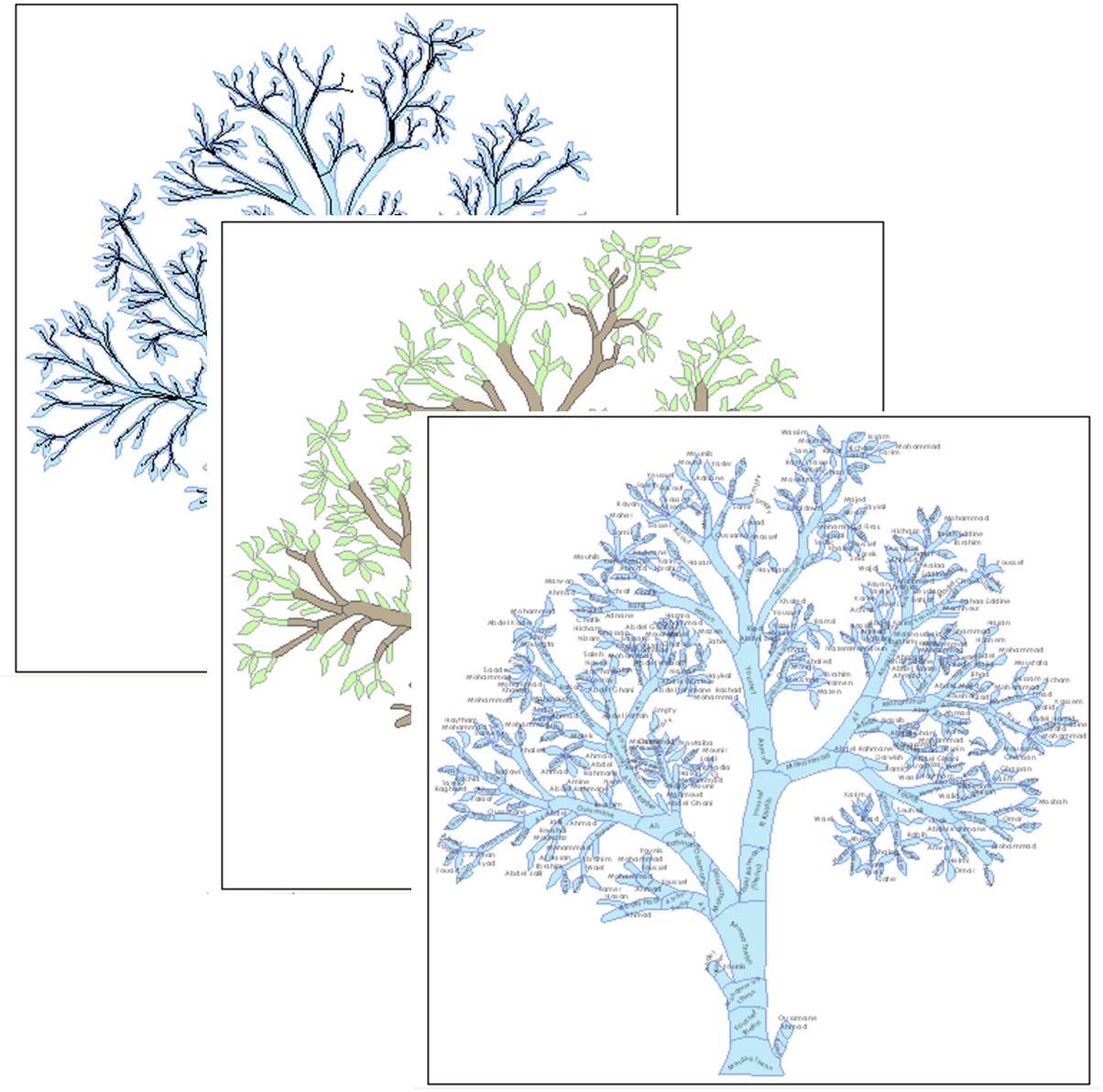
|
An interesting ArcNews article
gives accolades for unique use of GIS to Manal Sayed, of Khatib & Alami, who used GIS to reproduce the Khatib family progeny symbolized as an actual representation of a tree (ESRI, 2007)
. Sayed utilized ArcGIS’ sophisticated geodatabase structure, zooming, panning, querying, identifying, hyperlinking, and spatial analysis capabilities to store a raster image of a drawing of a tree and he created polygon feature classes where people were represented as one leaf feature or section of a branch or the trunk (ESRI, 2007)
. A geometric network was built from ancestors and descendants, and relationships were assigned, where each person was considered a junction (leaf) and father/child junctions were connected by an edge (branch), in which advanced editing capabilities allow for flexible expandability options (ESRI, 2007)
.
|
|
A number of articles have been written discussing the problems with tracing American Indian heritage, but also emphasizing the importance of oral tradition, because, even though “Indian Princess” is not a real Native American term, even factually false stories usually hold some nugget of truth (Warren and Carmack, 2009)
. Genealogy experts recommend visiting The U.S. National Archives and Records Administration (NARA)
research facilities, which houses great Native American research information and data on-line as well; The Department of the Interior and its Bureau of Indian Affairs
, which holds many frequently requested forms on-line; a number of other federal departments for Indian census, treaty, and annuity rolls; and local tribal enrollment offices, in which you could search “historical periodicals, church and cemetery records, newspapers, school records, diaries, maps, ledgers, biographies, and historical and ethnological series of publications”, many that are on-line (Warren and Carmack, 2009)
. DNA testing is also an option, although genetic testing is a controversial science and will not provide actual proof of a specific tribe affiliation, time period, or individual; however, DNA testing may lend clues as to whether or not Indian blood runs through ones veins by unveiling percentages of certain genetic markers, and inturn, potentially geographically locate a person’s heritage.(Warren and Carmack, 2009)
.
The USGS discusses various sources of maps for genealogy uses, such as historical, aerial photography, topographic and other relief maps, and they provide links to documentation on finding ancestors, and access to the Geographic Names Information System (GNIS) , which can be useful for locating certain places that may not be named the same as they once were (USGS, September 2002) . Knowing which county or town your ancestor is from or lived in can unlock mysteries, so maps can further your understanding of "where your relatives were born, resided, attended school, worked, shopped, voted, traveled over land or water, courted, married, raised families, and were laid to rest" (USGS, September 2002) . The Library of Congress and the National Archives are great sources for locating historical and pertinent maps for genealogical purposes (USGS, September 2002) . The article also mentions a pamphlet called Where to Write for Birth, Death, Divorce, and Marriage Records, which can be purchased from the U.S. Government Printing Office (USGS, September 2002) . The Cherokee Removal GIS data is available, reflecting the “Trail of Tears ” movement by land and water from In Time & Place , which was an event in United States history that involved the removal of Indians from places that white settlers wanted to inhabite in the southeastern states of Tennessee, Alabama, North Carolina, and Georgia, placing them in lands west of the Mississippi (Thomas, 2008) . One-third of the natives migrated west by 1820, then missionaries sprang up in order to try to civilize Native Americans, followed by interracial marriage, in order to recognize more extensive rights of Indians over tribal lands, but the discovery of gold in Georgia in 1828 escalated the desire of the State to remove Indians, ultimately resulting in the Treaty of New Echota, which was signed in 1835 by a small party of Cherokee leaders forcing the tribe to grant their lands away and remove to the West (Thomas, 2008) . | |
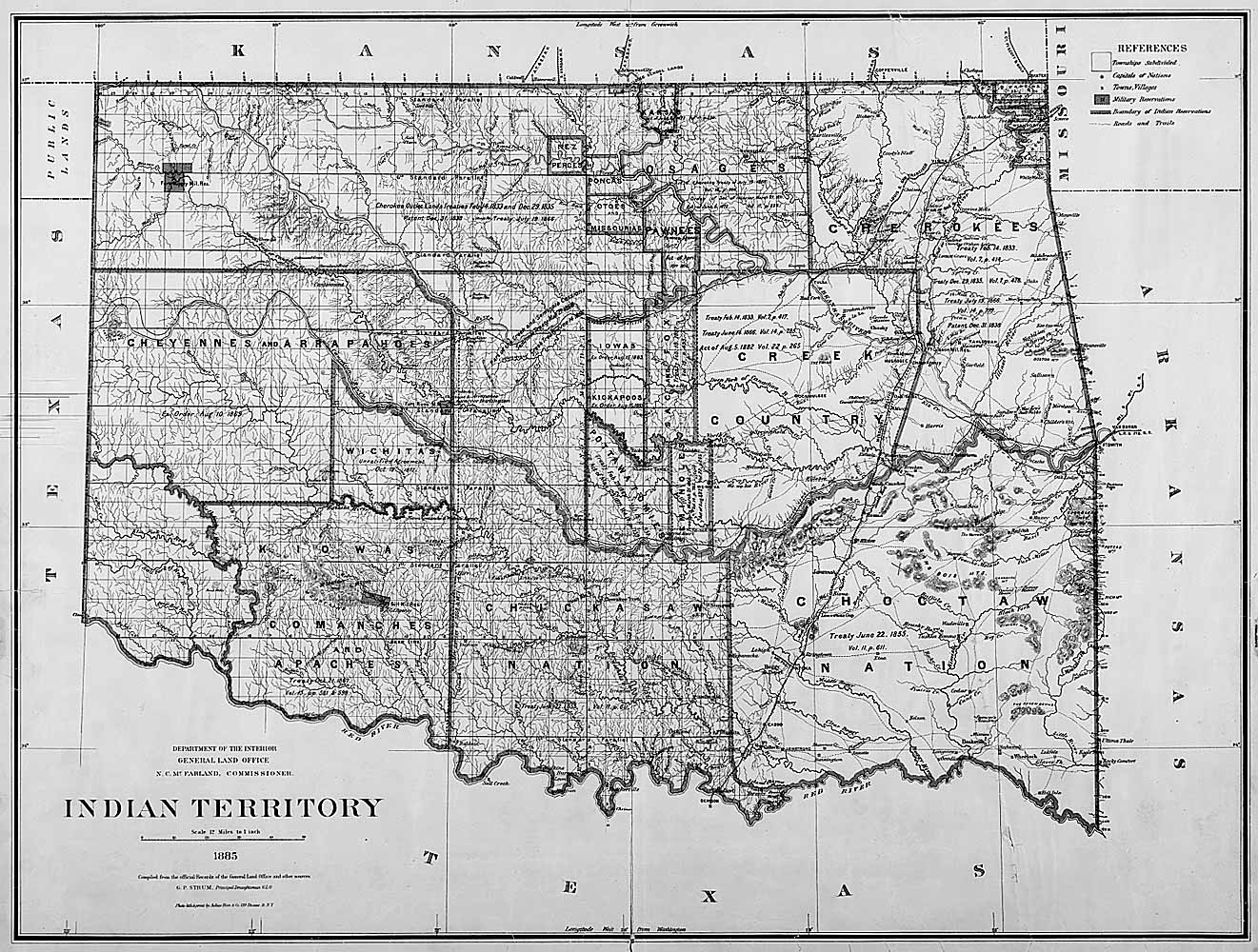
|
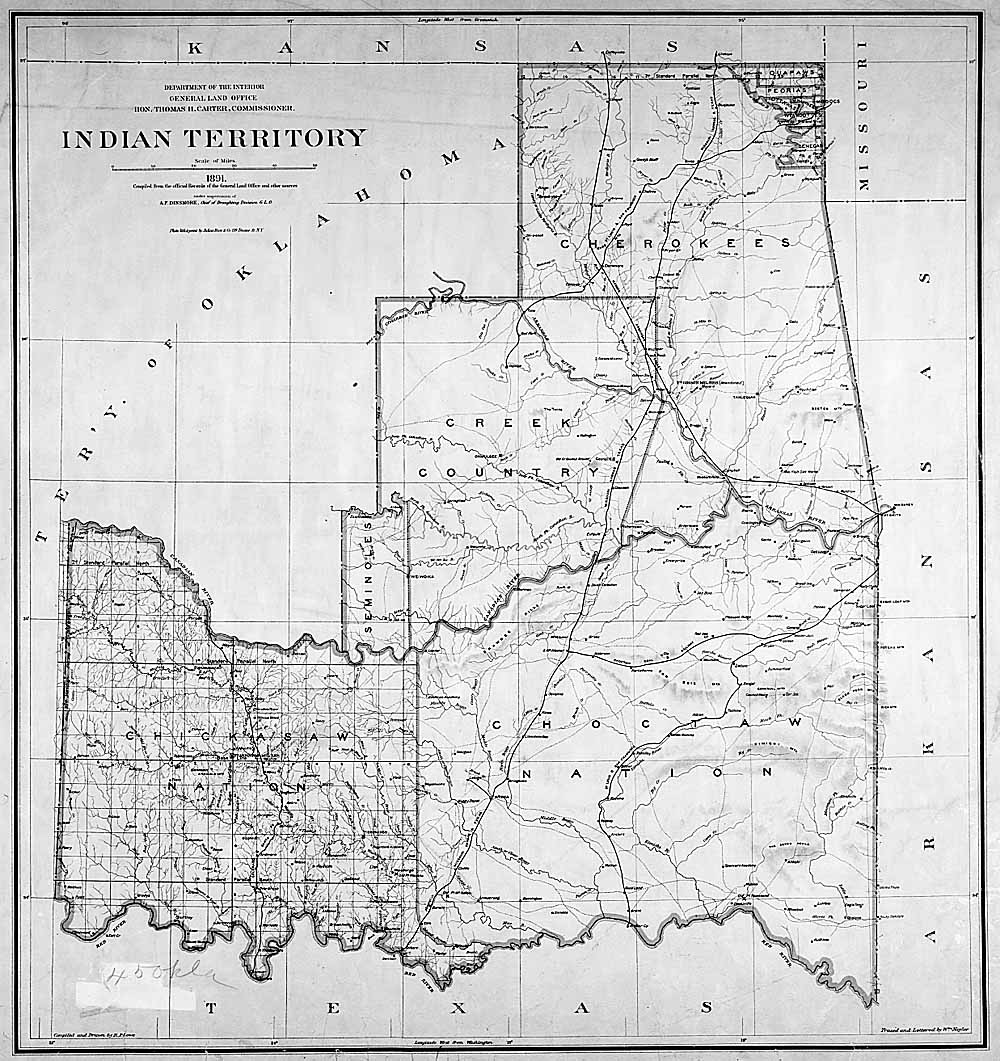
|
|
The maps above are of Indian Territory, published by the National Archives, before and after the enactment of the Dawes Act (a.k.a. General Allotment Act), passed on February 8, 1887 by Congress, which allowed the President to allocate reservation land to Native Americans who were registered on the roll; hence, “To each head of a family, one-quarter of a section; To each single person over eighteen years of age, one-eighth of a section; To each orphan child under eighteen years of age, one-eighth of a section; and To each other single person under eighteen years now living, or who may be born prior to the date of the order of the President directing an allotment of the lands embraced in any reservation, one-sixteenth of a section…” (Kelly, 2010)
. Cherokees, Creeks, Choctaws, Chickasaws, and Seminoles, known as the Five Civilized Tribes, were finally included in the law in 1893, and were given harsh desert or near-desert "farmland" in exchange for those tribes' willingness to abolish their tribal governments and recognize state and federal laws (Kelly, 2010)
.
"Indian Territory" refers to Oklahoma and the original tribes in that area were the following: The Plains Apache tribe The Arapaho tribe The Caddo tribe The Comanche tribe The Kiowa tribe The Osage tribe The Wichita tribe (Redish and Lewis, 2009) . Many "other tribes refused or resisted and were forcibly moved into Oklahoma by the US Army", whom were the following: The Arapaho tribe The Cayuga tribe The Cherokee tribe The Cheyenne tribe The Chickasaw tribe The Choctaw tribe The Creek tribe The Delaware tribe The Ioway tribe The Kaw tribe The Kickapoo tribe The Miami/Peoria tribe The Missouria-Otoe tribe The Modoc tribe The Ottawa tribe The Pawnee tribe The Ponca tribe The Potawatomi tribe The Quapaw tribe The Sac and Fox tribe The Seneca tribe The Shawnee tribe The Wyandotte tribe The Tonkawa tribe The Yuchi tribe (Redish and Lewis, 2009) . |

|
On the left shows some of the tribal boundary maps by state that are available from the Native Languages of the Americas website (Redish and Lewis, 2009). They may be useful in tribal boundary delineation required for a Native American GIS. This site has much valuable information relating to each geographical area and tribal affiliation. I recommend checking it out for anyone doing a Native American research project.
|
|
Methods One would usually compile his or her family tree data into some sort of hierarchal data structure, by hand or using some genealogy software, as I did, such as Family Tree Builder, free from MyHeritage.com. However, the first step would be to acquire the data by questioning any living family members for any memories they can recollect about the normal facts: names, dates, and places of common ancestors. My grandparents lived a hard life, especially my grandmother, whose parents deserted her and her brothers during the Great Depression; this probably being the main reason it was so difficult for my grandparents to discuss their pasts or share any knowledge of their distant families. Luckily, between what my mother’s recollection of what my grandmother told her and the memories of my grand-uncle, who is my grandfather’s brother, some hopeful light was shed on where my grandparents grew up and what tribes may be the right ones to research. Next, among multitudes of others, websites such as LDS.org , Ancestry.com , and AccessGenealogy.com are good starting points as a source of information, but my favorite go-to is simply Google.com . Birth, marriage, and death certificates can sometimes be ordered, often yielding additional information about a relative's parent’s names and birth place. Census records, land records, and other valuable documents add considerable validity to the recorded information and confirmation of the spelling of an individual’s name or age, since a family record passed down by word of mouth can sometimes be skewed or inaccurate. Inaccuracy is often caused by normal human error, like accidentally confusing family member names in conversation, which is a very common every day occurance in my family. |
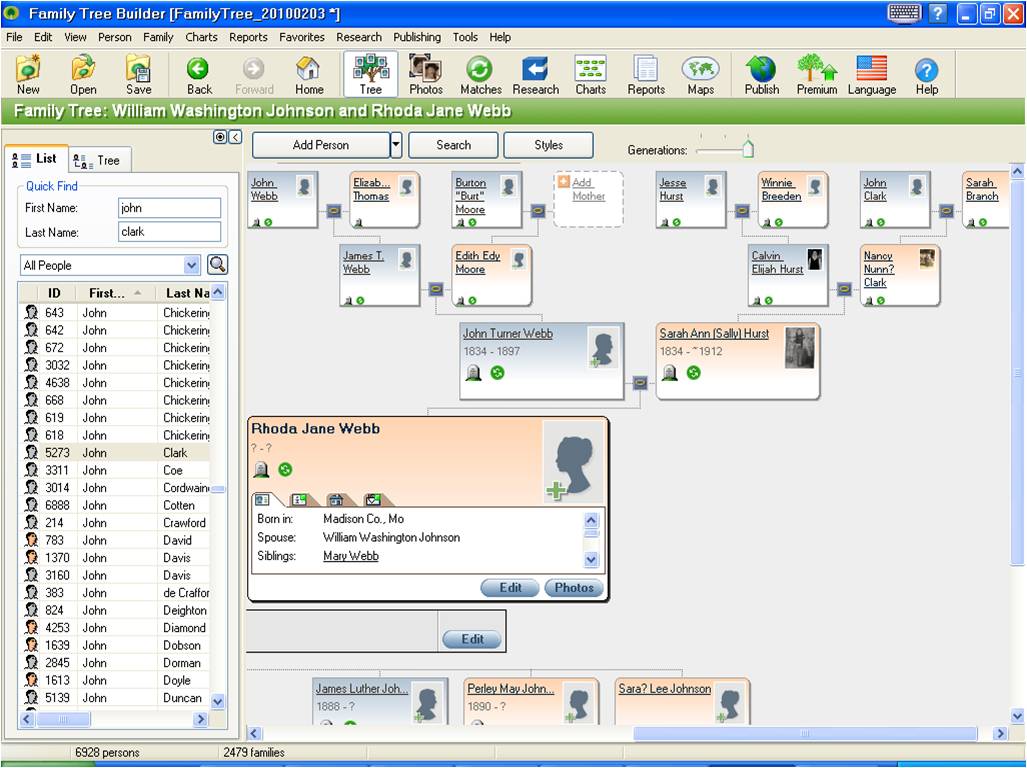
|
I have been using Family Tree Builder and producing GED pedigree files in the past, to upload and download information. It is a good program for producing reports, charts, and even maps, but I think GIS will add another dimension to my analysis capabilities. I am able to convert the GED file into a DBF file using
GEDxlate
and, coupled with EXCEL, I was able to edit and prepare the data for import into ArcGIS. I have data for each person, brthplace, death place, marriage, and other facts which were ultimately converted into a geodatabase.
|
|
I was fortunate to acquire Sayed’s patrilineage style prototype of the family tree using geometric networks in GIS; however, due to a significant time constraint in adopting it for my project at this time, and the fact that I would want to adapt it into a matrilineal tree design from the roots of the tree, I am taking a different approach to how I am applying GIS to draw my family connections. Although Sayed’s method may be more ideal in the future for it's creative aesthetics, I have a different GIS design in mind.
|

|
Instead, I am drawing simple polygon boxes to display my ancestors’ names and hold the attributes about them, such as their date of birth; death; marriage; birthplace; where they were married; place of death; and the identification numbers (ID) of their spouses and parents. I show the relationships using simple line graphics for now. The further back in time I add to the tree, I can fairly simply add more parents above each child, in one vast and seemingly limitless space, for better visualization of the interconnectedness and broadness of all the branches at once. The family members highlighted on the left are the ones I believe to be of Native American descent.
|

|
Also, hyperlinked photographs, documents, and other images are to be linked to family members, which will automatically pop-up when activated.
|
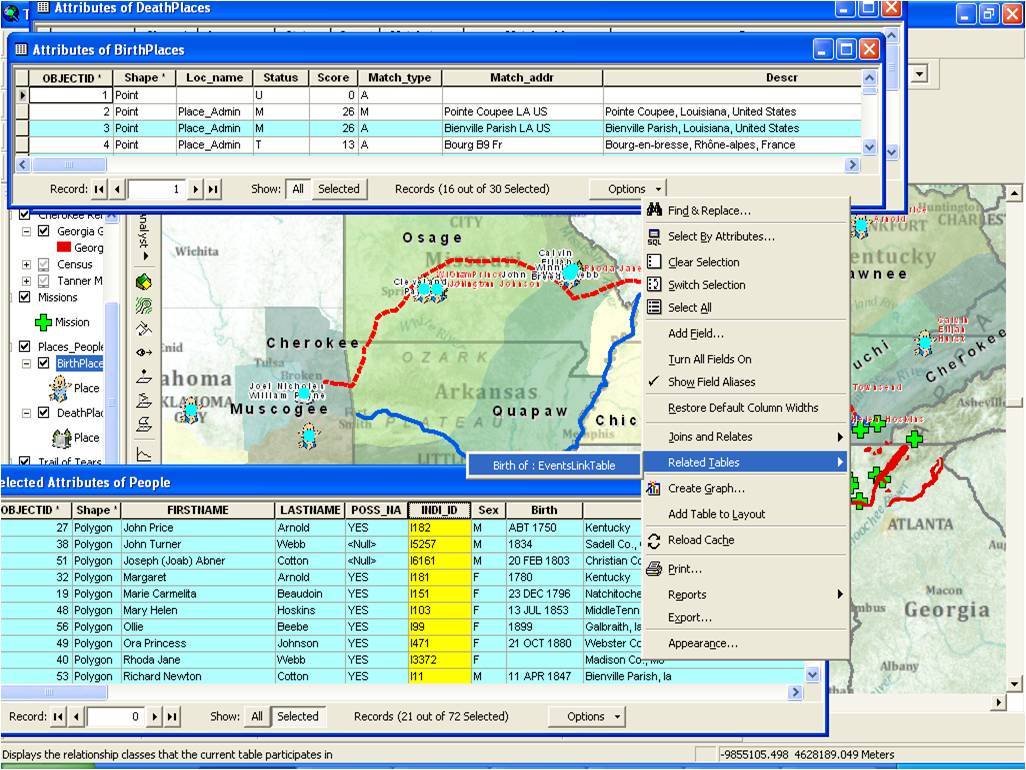
|
I primarily want to use ArcGIS’ relational analysis methods, by being able to select a person in a box, and then relate that person to a location on the map below to both their place of birth and death; and vice-versa.
|
|
The tribe boundary maps I obtained from Native Languages of the Americas were georeferenced and digitized for the approximate tribal limits in the states I have suspect ancestors of Native American descent. I was able to create a tabular report of who were born or died within specific tribal territory for my research. In building the maps, I used the ArcGIS Online Service address locators found at:
tasks.arcgisonline.com
, along with the Geocoding Review/Rematch Addresses functionality that ArcMap offers to locate each place. It is easy to add more places to the geodatabase from csv or dbf files and using the normal ArcMap Editor tools. The geodatabase will be used to identify specific tribes to further research, in order to try to find legitimate Native American documentation about my ancestors in the future.
| |

|
Specific to Native American heritage research, information like The Index to the Final Rolls of Citizens and Freedmen of the Five Civilized Tribes in Indian Territory (Dawes) is published on-line by The U.S. National Archives and Records Administration (NARA, 2010)
. Knowing what part of the country the family members were born or died at, is a huge time factor in filtering and sorting through the rolls and other Native American documentation found on the internet. There are links to over 600 pages of roll indexes, organized by tribe and enrollment category, such as by “Blood”, “Minor”, “Freedman”, “Newborn”, and “Intermarriage”. When a potential family member and their final roll number is found, a hard copy of the census card can be purchased for $25, in which a lot of information can be collected; such as the person’s place of birth, parent’s names and place of birth, and the reason why they believe themselves to be Native American. I was fortunate to find my great grandparents on the Guion Miller Roll Index
of applicants to be enrolled on the Eastern Cherokee Roll of 1909, so I ordered copies of their applications to find out if they were rejected or accepted.
(NARA, 2010)
|
|
Results
Below I will illustrate and discuss the findings of my research. Although my questions have not been answered as fully as I would like, interesting conclusions have been made by others in the field of genealogy about commonly related family members that may have Native American roots. Those observations and other information collected has been further studied by myself and reorganized in a GIS for further analysis. The results ultimately point towards Shawnee as a possible tribal affiliation to my family. | |
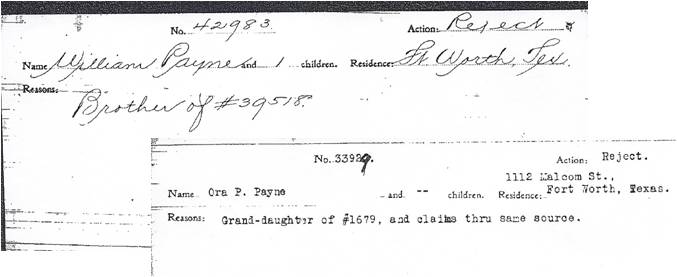
|
The results in acquiring my great grandparents’ Eastern Cherokee applications unfortunately showed that they were denied. Reasons were vague, referring to other family member application numbers. However, names of the relatives they believed to be their Native American ancestors were listed for me to follow up on, as well as names and details of their parents and grandparents. Maybe they descended from a different Indian tribe other than the Five Civilized Tribes.
|
|
Also included in the Eastern Cherokee application packages were hand written lettters from my great-grandparents to Mr. Guion Miller, which included their addresses of where they resided. Therefore, as a continuation of my genealogy legacy not specific to this Native American analysis, I could map their addresses, which a few, as they sent several change of address letters, possibly in desperation due to financial struggles. I was able to map my ancestors and many of them do indeed appear situated where Indian Territory would have been, perhaps coincidentally along the trail of tears pattern, but indicating that it is very plausible that there is Native American bloodlines. I was able to outline eighteen generations of what I’ve discovered about my family, in report form extracted from MyHeritage Family Tree Builder
, with photographs embedded. Following are examples of what I have to show for my research.
| |
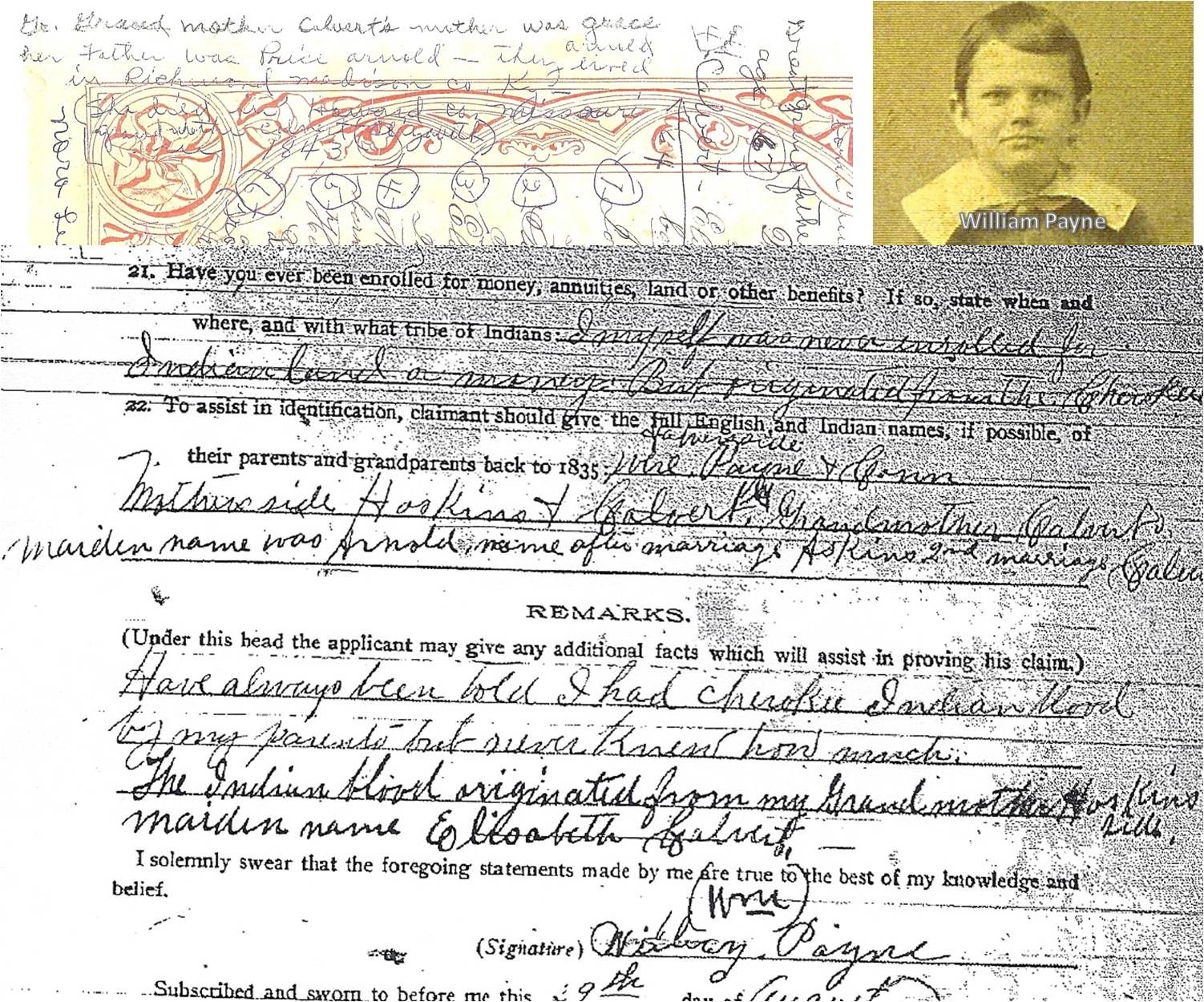
|
According to a family bible passed down to a second cousin I contacted, Anita Kilbourne in 2002, my great-grandfather William Payne's Native American roots have been traced to an elusive Grace (Franny), born about 1780, assuming Kentucky, and she died in Missouri. I was also given a copy of a childhood photograph of William, which is the first photograph my mom has ever layed eyes on of one of her grandparents. According to Kilbourne, Grace had a will that was filed in Will Book 1, Howard Co., Missouri on May 28, 1821 (Film area 0870011 Item 5. Book area 977.8285) that I may locate one day soon to futher my investigation. Will's Eastern Cherokee application testimony on who his relatives are matches what Kilbourne shared with me. |
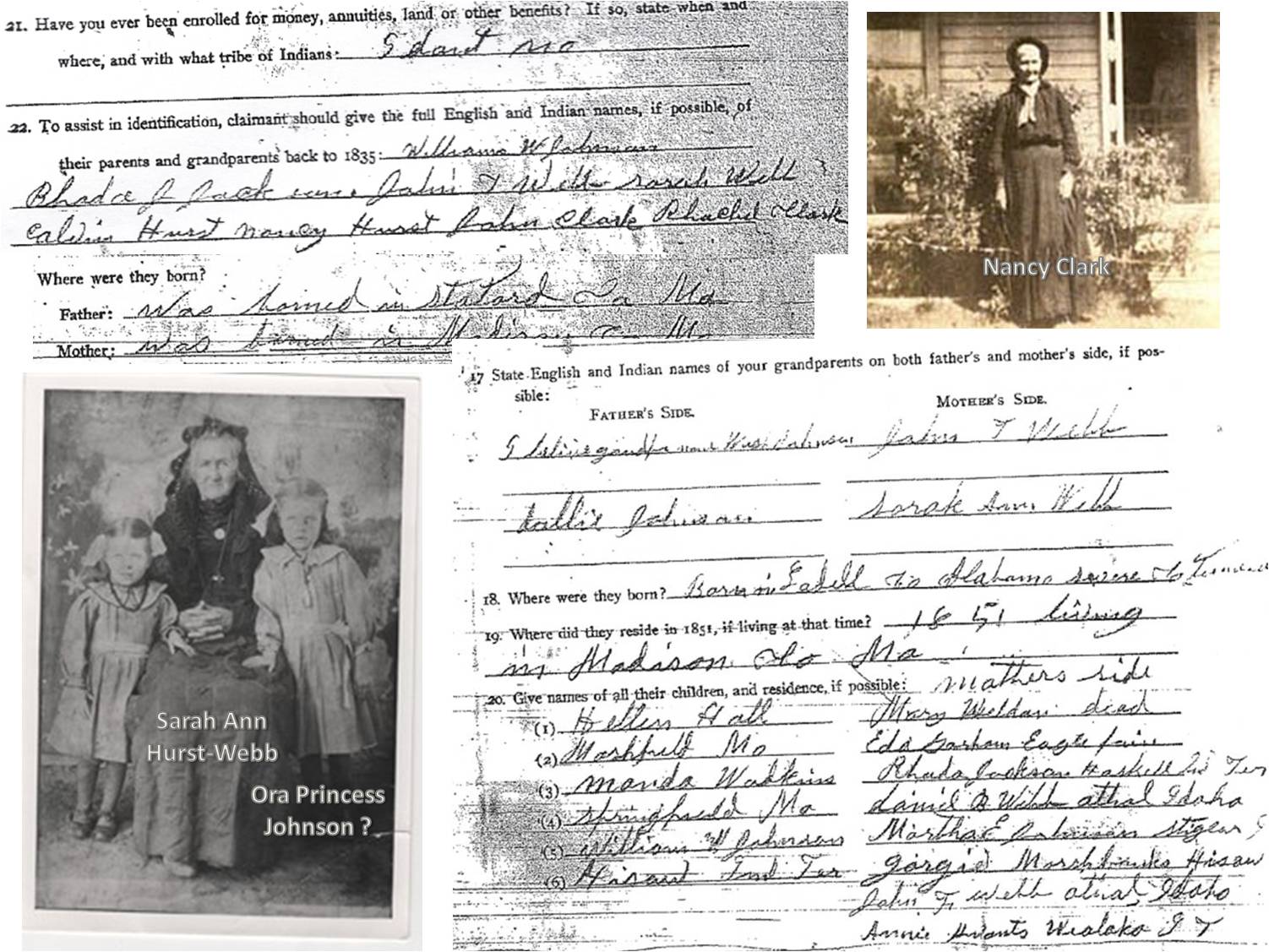
|
My great-grandmother Ora Princess Johnson's Indian roots allegedly stem from a John Clark and his daughter, Nancy. There are various pedigree claims that John Clark's wife and mother to Nancy was Sarah Branch, but Ora's Eastern Cherokee application indicates that her name was Rhachel. I also obtained a photograph that shows my great-great grandmother Sarah Ann (Sally) Webb sitting with the "Johnson Girls", one of them very possibly being my great-grandmother Ora herself, as a child (Ancestry.com, 2010)
.
|

|
On my grandfather's side, the Cotten or Cotton family was of interest because my great-great-great-great grandfather married Sarah Jane Walls, who according to pedigree records, was born in Kentucky and the following was recited, "Now something interesting about Joab Cotten is this. All his wives had Indian Blood... Grandmother Amanda Melvina Wilkerson said her mother had Cherokee blood in her..." (Billy & Rita, 2008)
. There are several discrepencies on when she died.
|
|
Also according to family records issued to a Lousiana specific website by another recently found cousin, Melanie W. Dotson, whom I also contacted directly via e-mail on March 1, 2010, "Joab married (wife #4) Sarah Jane Smith Walls who was the daughter of Newton Smith and Elizabeth Dillard. Later her mother married a Jesse Walls and Sarah adopted this name. They were living in Crittenden County according to the State census which con sides with Montreville being born in 1839 in Arkansas. I know this is where he married Sarah but I have no record of their marriage..." (Billy & Rita, 2008)
.
| |
|
Figures and Maps
| |
 |
The ArcGIS map shown on the left is of my family members rumored to be my Native American ancestors, so I could discern whether or not they were in or around American Indian lands or along or near the Trail of Tears. The map shows my family clustered around Native American land and especially along the Cherokee removal routes. However, I was surprised to learn that some of my ancestors thought to be of Native American blood, may have just been situated in Indian Territory as European settlers.
It is also stated that Native Americans frequently intermarried in order to escape the fate of removal to an Indian reservation or even death (Redish and Lewis, 2009) . Tribes have "had plenty of blue-eyed individuals after colonization, such as the Lumbees and the Cherokees, because those tribes lived in close contact with a Caucasian community as large as their own", which makes this story's legitamacy difficult to prove (Redish and Lewis, 2009) . |
 |
The example ArcMap report generated on the left shows some of my ancestors who are potentially of Native American descent, and which tribal areas they were born in. This will allow me to further my research efforts for particular tribes to see if I can find any truth to the speculations; however, many of the names will be eliminated if it is obvious that they moved away from the tribe and into mainstream living, most likely when the root ancestor married a white person or if it is known that they were not born where their parents were. |
|
Analysis
My research involved laborously searching for any records that have my ancestors names on them, hoping to match their birthdates, year of death, parents names, spouse name, or childrens names. Census records and personal family trees from Ancestry.com are great for finding entire families that were living together, gaining insight into not only how many children they had and how their names were spelled, but also how they lived and if they took care of their elders, as I found in several census records. My research took some unexpected, disappointing, and hopeful turns during this process. Focusing my analysis on the first known Native Americans in my family and assuming the place of birth outweighs where they died, my analysis at this time indicates my family may potentially be from the Shawnee and Caddo tribes. | |

|
It is plausable that Grace was born closer to where her husband, John Price Arnold was from, who was born in Kentucky (predominately Shawnee Territory), especially since her daughter Margaret Calvert was born there as well, according to pedigree files sent to me from Anita Kilbourne, dated May 3, 2002. Uncertain information lends to the approximate locals of John Clark and Newton Smith that were added post-GIS. Sarah Smith was also born in Kentucky, but Cherokee Territory is ruled out due to my inability to find anyone on any of the Cherokee rolls. Another likely possibility may be that her family removed to Arkansas, given that she was married and had a child there, but finding out which part of Kentucky and tribe they are really from requires further investigation. (Billy & Rita, 2008) . |

|
I was unsuccessful in finding any relatives officially registered in the Final Dawe’s or Guion Miller Rolls, but I did find some clues in some of the older rolls that may be of substance. John Clark was located on the 1917-1935 Emigration Rolls; however, it is uncertain as to whether or not he is the John Clark that is claimed to be the father of Nancy Nunn Clark, only based on the dates of the rolls falling within his lifetime (Blankenship, 1992). Nancy's birth place is not known, and various pedigree files claim "Nunn" to be part of her name (Ancestry.com, 2010). This too will require more research. |

|
Again on my grandfather's side, I discovered who I was sure to be the “Indian Princess” I had been searching for, only to be rejected by the uncertain fact that one of my Beebe ancestor’s biological mother may not be who I thought she was. A report given to me from a distant cousin, Frank Roshto, is abstracted on the left from an e-mail attachment received March 19, 2010. The Indian’s name was Angelique, from the Hasinai tribe (Caddo Nation), who was thought to be the daughter of an Indian Chief and an interpreter for the French and Spanish in the early 1700s, also documented on a family project website (Roshto and Rocheteau, 2010).
I even located books and a beautiful rendition painting of her, that amazingly resembled my mother. However, Angelique’s descendant, Sarah Rochetau, may not be the mother of our William M. Beebe, as I originally thought, since Beebe family tales holds that Rev. Asa P. Beebe had William from a previous marriage before he married Sarah (Roshto and Rocheteau, 2010). If this is true, even the French/Creole legends that our family has always believed, would be crushed. This will require more research before I dismiss that line in my family tree. However, I have some evidence to the contrary that lends truth that William’s mother really is the Sarah Rochetau or Roshto that is Angelique’s direct descendant, based on U.S. and International Marriage Records, 1560-1900 records claiming Rev. Asa P. Beebe and Sarah Roshto were married in 1844, one year before William was born (Ancestry.com, 2010). |
|
Name changes for Indians in general is a huge obstacle in this type of research, but the fact that my family had such common names, like John Clark, makes information gathered about some of my ancestors difficult to prove. Records are also scarce for Native Americans, especially in the early 1800s or further back in time. Added to that dilemma is the fact that many of them were fleeing or blending into mainstream society rather than be documented as an Indian. Other issues and difficulties encountered include different projection warping problems while trying to georeference images of the Indian Territories from sources I decided not to use, conflicting information about the same individual from various sources, lack of information available, last name changes or misinformation (such as if the person re-married or took their step-father’s name), illegitimate births or uncertain genetic parents, and lack of time to complete my study in its entirety.
| |
|
Conclusions
If my family can get DNA testing showing true Native American strains, I feel this study will be a worthy lifelong investigation, but there are many factors to consider before doing so, in order to get trustworthy results. My next step would be to try to locate William M. Beebe’s birth certificate from the Louisiana State Archives to find out who his birth mother really is. I would also like to order the Eastern Cherokee applications of William Payne’s brother and Ora Payne’s grandmother, whom their rejection letters referred to in being the cause for the dismissal of their Cherokee claims. They either really were Cherokee and chose not to be listed on Indian rolls, or they were possibly Shawnee or Yuchi. Of course, a road trip to the main U.S. states of interest is on the agenda, especially to Kentucky and Louisiana, and locate more sources of Shawnee and Caddo ancestry information. The possibilities are endless as to how I can keep building on to my ancestry GIS for other branches of my family tree. I may even add timelines to my GIS using the Linear Referencing Tools in ArcMap. Regardless, I don’t think I will ever give up my quest for the truth about my ancestors. I plan to continue trying to recollect and rediscover the memory of them for my family to enjoy, and hopefully pass down my data to a future generation of family story keepers, who may continue the search for where and who we really came from. | |
|
References Billy & Rita, 2008. Louisiana Ancestry and Genealogy Information. Louisiana Kinfolk. http://www.louisianakinfolks.com (accessed April 1, 2010). Blankenship, Bob, 1992. "1817-1835 Emigration Roll." In Cherokee Roots, Volume 1: Eastern Cherokee Rolls, 17-19. Cherokee, North Carolina: 17th Printing. Kelly, Kerry C., 2010. Teaching With Documents: Maps of Indian Territory, the Dawes Act, and Will Rogers' Enrollment Case File. The U.S. National Archives and Records Administration (NARA). http://www.archives.gov/education/lessons/fed-indian-policy (accessed April 1, 2010). Oser, Anita, 2005. Using GIS to Map Genealogical Data: Getting Started. World Library and Information Congress: 71th IFLA General Conference and Council, August 14th - 18th 2005. http://archive.ifla.org/IV/ifla71/papers/201e-Oser.pdf (accessed April 1, 2010). Redish, Laura, and Orrin Lewis, 2009. Native American Tribes of Oklahoma. Native Languages of the Americas. http://www.native-languages.org/oklahoma.htm (accessed April 1, 2010). Roshto, Frank, and Rocheteau, Robert J., 2010. The Rocheteau [Roshto] Family in Louisiana. Rocheteau Genealogy. http://www.rocheteau.org/New_World/Louisiana/Louisiana_Rocheteaus.htm (accessed April 1, 2010), email dated March 19, 2010. Sayed, Manal, 2007. ArcNews Spring 2007: GIS Preserves Family Ties. Environmental Systems Research Institute, Inc. (ESRI). http://www.esri.com/news/arcnews/spring07articles/gis-preserves-family.html (accessed April 1, 2010). Thomas, Rick, 2008. The Cherokee Removal. In Time and Place. http://www.intimeandplace.org/cherokee/index.html (accessed April 1, 2010). USGS, 2002. Using Maps in Genealogy, Fact Sheet 099-02. U.S. Geological Survey (USGS). http://egsc.usgs.gov/isb/pubs/factsheets/fs09902.html (accessed April 1, 2010). Warren, James W., and Sharon D. Carmack, 2009. Indian Territory. Family Tree Magazine. http://www.familytreemagazine.com/article/Indian-Territory (accessed April 1, 2010). | |
|
Links ESRI || ArcGIS Online Service || NBC || Ancestry || MyHeritage || Ancestral Atlas || GEDxlate
U.S. Board on Geographic Names|| LDS Family Search
|| Google
For more information and tips specific to Native American research:
The U.S. National Archives and Records Administration (NARA) ||
Bureau of Indian Affairs (BIA)
AccessGenealogy
||
Native Languages of the Americas
| |